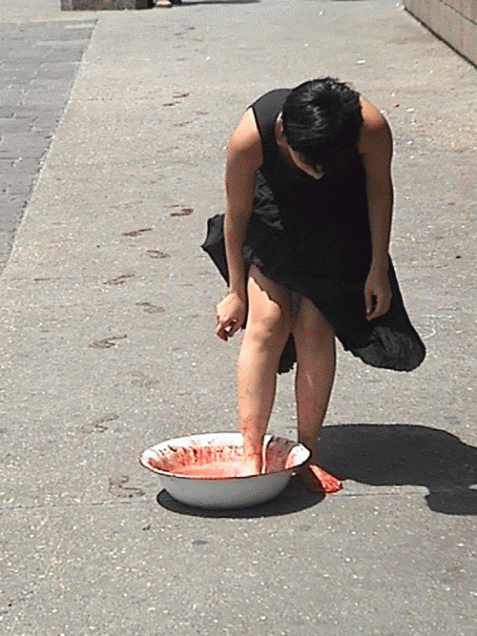Unfazed bystanders shuffle past Regina José Galindo as she carries a large bowl of swishing blood, real blood. At every seven or eight paces, the performance artist lowers the bowl to the ground, steps into the blood, and marks the streets of Guatemala City with red footprints. Dressed in a black dress, as if in mourning, she traces a path from the Constitutional Court to the National Palace. As seen in a video and photographs, Galindo’s 2003 public performance ¿quién puede borrar las huellas? (Who Can Erase the Footprints) was a response to a recent change in the constitution by the Constitutional Court that removed a ban preventing former dictators, like José Efraín Ríos Montt, from becoming presidential candidates. Decades prior, Ríos Montt oversaw the genocide of indigenous Maya Guatemalans. Galindo’s performance—her freshly dipped feet at first leave blood-saturated prints but fade after a few steps—was intended to call attention to the quickly forgotten crimes against humanity that Ríos Montt committed.
The exhibition “Regina José Galindo: Bearing Witness” at Davidson College’s Van Every/Smith Gallery was thoughtfully curated by Lia Newman. Sounds of moaning and banging from footage of Galindo’s endurance performances echo through the galleries. The C-prints, video screens and objects that fill the galleries are remnants of 23 of these acts. The severity of the performances makes the show heavy.
In 1996, Galindo began writing poetry, and her practice evolved to utilizing her body during readings. Not long after her poems grew into performance, Galindo won the Golden Lion at the 2005 Venice Biennale. Her expedited success no doubt stems from the poetic potency of her work.
Much of the exhibition includes memorial performances for Guatemalan victims. For XX, she constructed 52 anonymous tombstones at the site of a mass grave in La Verbena Cemetery in Guatemala City. And in Extensíon (Extensions), the artist collected hair from unidentified female victims in the same cemetery. The artist and other volunteers wore the extensions sewn into their hair for a week. Galindo’s work extends mercy to the suffered men, women and children buried in this mass grave.
In no perdemos nada con nacer (We Do Not Lose Anything With Being Born), the artist lays naked inside a clear plastic bag in a landfill. Workers pass by her body unalarmed. As in many of Galindo’s performances in the exhibition, the audience’s reaction completes the work. Galindo provokes and the Guatemalans do not flinch. Perhaps, the country’s political turmoil has rendered the people desensitized, or too threatened to intervene.
The look and feel of Galindo’s performances relate to her female performance predecessors. Marina Abramović and Ana Mendieta, who have passively endured pain and discomfort. But Galindo’s use of materials are not symbols for essentialism. Galindo’s performances offer specificity. They are metaphors rich with the sincere context of distinct events. Galindo’s metaphors depend on her audience’s reaction. And that dependency extends through the exhibition to Davidson College and to North Carolina. Just as the passive viewers in the streets of Guatemala City the visitor’s response informs the work.
On Thursday, September 17, 6pm–8pm, Davidson College will host a reception and commissioned performance. Regina José Galindo will also give a presentation Friday, September 18, 7-8pm at the 21C Museum Hotel in Durham, North Carolina. “Bearing Witness” is on view through October 24.
Kellie Bornhoft is an artist and writer living in Raleigh, North Carolina. She is a current participant in BURNAWAY’s Emerging Art Writers Mentorship Program.
View original article from Burnaway here.

